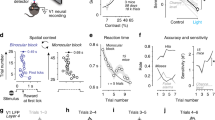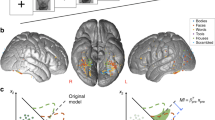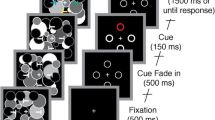Abstract
High- and low-sensation seeking behaviors in human and cat are shown to be correlated with visual evoked potential (VEP) augmenting and reducing, respectively. Demonstration of this relationship in RHA/Verh and RLA/Verh rats provides a heuristic animal model with which to investigate the physiological and genetic basis of this relationship. Recent work is described which shows that VEP augmenting and reducing is a true cortical phenomenon and not merely a reflection of differences occurring at the thalamus. Recent evidence is discussed that suggests the role of diffuse subcortical monoaminergic projections to the cortex as the neurochemical basis for sensation seeking behaviors controlled by prefrontal and limbic cortex and perhaps the correlated VEP augmenting/reducing responses recorded from the posterior cortex.
Similar content being viewed by others
REFERENCES
Blennen, J. L., and Yingling, C. D. (1993). Modality specificity of evoked potential augmenting/reducing. Electroencephalogr. Clin. Neurophysiol. 88:131–142.
Buchsbaum, M. S. (1971). Neural events and the psychophysical law. Science 172:502.
Buchsbaum, M. S., and Pfefferbaum, A. (1971). Individual differences in stimulus intensity response. Psychophysiology 8:600–611.
Buchsbaum, M., and Silverman, J. (1968). Stimulus intensity control and the cortical evoked response. Psychosom. Med. 30:12–22.
Buchsbaum, M. S., Landau, S., Murphy, D. L., and Goodwin F. (1971). Average evoked response in bipolar and unipolar affective disorders: Relationship to sex, age of onset and monoamine oxidase. Biol. Psychiat. 7:199–212.
Buchsbaum, M. S., Haier, R. J., and Johnson, J. (1983). Augmenting and reducing: Individual differences in evoked potential. In Gale, A., and Edwards, J. (eds.), Physiological Correlates of human Behavior: Individual Differences and Psychopathology, Vol. 3, Academic Press, London, pp. 120–138.
Carrol, E. N., and Zuckerman, M. (1977). Psychopathology and sensation seeking in “downers,” “speeders,” and “trippers”: A study of the relationship between personality and drug choice. Int. J. Addict. 12:591–601.
Charnay, Y., Steiner, T., Huguenin, C., and Driscoll, P. (1995). [3H]Paroxetine binding sites: Brain regional differences between two psychogenetically selected lines of rats. Neurosci. Res. Commun. 16:29–35.
Cooper, J. R., Bloom, F. E., and Roth, R. H. (1996). The Biochemical Basis of Neuropharmacology, Oxford University Press, New York.
D'Angio, M., Serrano, A., Driscoll, P., and Scatton, B. (1988). Stressful environmental stimuli increase extracellular DOPAC levels in the prefrontal cortex of hypoemotional (Roman high-avoidance) but not hyperemotional (Roman low-avoidance) rats. An in vivo voltammetric study. Brain Res. 451:237–247.
Driscoll, P., and Battig, K. (1982). Behavioral, emotional and neurochemical profiles of rats selected for extreme differences in active, two-way avoidance performance. In Lieblich, I. (ed.), Genetics of the Brain, Elsevier Biomedical Press, Amsterdam, pp. 95–123.
Driscoll, P., Woodson, P., Fumm, H., and Battig, K. (1980). Selection for two-way avoidance deficit inhibits shock-induced fighting in the rat. Physiol. Behav. 24:793–795.
Driscoll, P., Dedek, J., Martin, J., and Zivkovic, B. (1983). Two-way avoidance and acute shock stress induced alterations of regional noradrenergic, dopaminergic and serotonergic activity in Roman high-and low-avoidance rats. Life Sci. 33:1719–1725.
Fernández-Teruel, A., Escorihuela R. M., Nuñez, J. F., Gomà, M., Driscoll, P., and Tobeña, A. (1992). Early stimulation effects on novelty-induced behavior in two psychogenetically-selected rat lines with divergent emotionality profiles. Neurosci. Lett. 137:185–188.
Gentsch, C., Lichtsteiner, M., and Feer, H. (1991). Genetic and environmental influences on reactive and spontaneous locomotor activities in rats. Experientia 47:998–1008.
Giorgi, O., Orlandi, M., Escorihuela, R. M., Driscoll, P., Lecca, D., and Corda, M. G. (1994). GABAergic and dopaminergic transmission in the brain of Roman high-avoidance and Roman low-avoidance rats. Brain Res. 638:133–138.
Giorgi, O., Corda, M. G., Carboni, G., Frau, V., and Di Chiara, G. (1997). Effects of cocaine and morphine in rats from two psychogenetically selected lines: A behavioral and brain dialysis study. Behav. Genet. 27:537–546.
Hall, R., Rappaport, M., Hopkins, H., Griffin, R., and Silverman, J. (1970). Evoked response and behavior in cats. Science 170:998–1000.
Lukas, J. H., and Seigel, J. (1977). Cortical mechanisms that augment or reduce evoked potentials in cats. Science 198:73–75.
Saxton, P., Siegel, J., and Lukas, J. (1987a). Visual evoked potential augmenting/reducing slopes in cats. 1. Reliability as a function of flash intensity range. Person. Individ. Diff. 8:499–509.
Saxton, P. M., Siegel, J., and Lukas, J. H. (1987b). Visual evoked potential augmenting/reducing slopes in cats. 2. Correlations with behavior. Person. Individ. Diff. 8:511–519.
Segal, B., Huba, G., and Singer, J. (1980). Drugs, Daydreaming, and Personality: A Study of College Youth, Erlbaum, Hillsdale, NJ.
Siegel, J., Sisson, D. F. and Driscoll, P. (1993). Augmenting and reducing of visual evoked potentials in Roman high-and low-avoidance rats. Physiol. Behav. 54:707–711.
Siegel, J., Gayle, D., Sharma, A., and Driscoll, P. (1996). The locus of origin of augmenting and reducing of visual evoked potentials in rat brain. Physiol. Behav. 60:287–291.
Soskis, D. A., and Shagass, C. (1974). Evoked potential tests of augmenting and reducing. Psychophysiology 11:175–190.
von Knorring, L. (1981). Visual averaged evoked responses and platelet monoamine oxidase in patients suffering from alcoholism. In Begleiter, H. (ed.), The Biological Effects of Alcohol, Plenum Press, New York, pp. 270–291.
Zeier, H., Battig, K., and Driscoll, P. (1978). Acquisition of DRL-20 behavior in male and female, Roman high-and low-avoidance rats. Physiol. Behav. 20:791–793.
Zuckerman, M. (1971). Dimensions of sensation seeking. J. Personal. 36:45–52.
Zuckerman, M. (1979). Sensation Seeking: Beyond the Optimal Level of Arousal, Erlbaum, Hillsdale, NJ.
Zuckerman, M. (1987). Biological connection between sensation seeking and drug abuse. In Engle, J., and Oreland, L. (eds.), Brain Reward Systems and Drug Abuse, Raven Press, New York.
Zuckerman, M. (1989). Personality in the third dimension: A psychobiological approach. Person. Individ. Diff. 10:391–418.
Zuckerman, M., Murtaugh, T., and Siegel, J. (1974). Sensation seeking and cortical augmenting-reducing. Psychophysiology 11:535–542.
Author information
Authors and Affiliations
Rights and permissions
About this article
Cite this article
Siegel, J. Augmenting and Reducing of Visual Evoked Potentials in High- and Low-Sensation Seeking Humans, Cats, and Rats. Behav Genet 27, 557–563 (1997). https://doi.org/10.1023/A:1021409132320
Issue Date:
DOI: https://doi.org/10.1023/A:1021409132320




